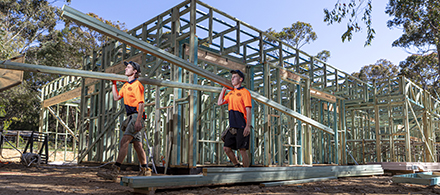Population growth and finance will constrain building activity heading into 2021/22 and reach a trough in the September 2021 quarter, according to the Housing Industry Association. Source: Timberbiz
The HIA says that prior to CoViD-19, population growth had already fallen well below expectations as overseas migration and the natural rate of population growth fell.
“Left unchecked, this will lead to more subdued building activity over the decade ahead,” HIA’s Chief Economist Tim Reardon said.
The HIA’s quarterly State and National Outlook Report released yesterday include forecasts for new home building and renovations activity for Australia and each of the eight states and territories.
Mr Reardon said that the contraction in migration due to CoViD-19 will further impede building activity over the decade.
“Due to this slower rate of population growth, we now expect starts to be around 172,000 by 2030, compared with 190,000 starts in our previous long-term forecasts,” Mr Reardon said.
“For comparison, in 2016, new home starts peaked at 234,000. This record number appears likely to be unparalleled for more than a decade.”
He said access to finance to build a new home will also continue to drag on the recovery of the housing market.
“In the years since the GFC, Australia’s financial market and banking regulators have tightened lending requirements. It is now harder for a first-home buyer with a 10% deposit to access finance than it was in 2009.
“If we were to return to previous lending practices, the Australian economy would recover faster from the COVID-19 recession,” Mr Reardon said.
HomeBuilder would support employment across the residential building industry and therefore across the wider economy over the short-term and early data indicated that it would be successful in supporting building activity in the December quarter and into 2021.
“Even with the resilient performance of the Australian economy and the impact of HomeBuilder, the expectation is that the number of new home starts will contract from 173,000 in 2019/20 to 139,700 in 2020/21,” Mr Reardon said.
He said the multi-unit market would bear the brunt of the COVID-19 shock.
“The contraction in multi-unit starts will occur sooner and be more pronounced than for the detached market and focused on high rise apartments due to the abrupt halting of migration,” Mr Reardon said.
“A slowing in multi-unit starts had been underway since 2018 when starts in this part of the market exceeded 100,000 annually.
“We anticipate that the detached home building market will slow down heading into 2021/22 and reach a trough in the September 2021 quarter. This reflects the impact of HomeBuilder drawing forward starts into the March quarter as well as the economic slowdown due to the recession.
“Of course, this positive outlook is dependent upon the progress of the pandemic and even with a rapid recovery from this recession, the Australian economy will not return to the level of wealth experienced in 2019 for a number of years,” Mr Reardon said.
HIA’s Executive Director – Victoria Fiona Nield said the uncertainty around future migration activity was a greater risk to the long-term outlook for Victoria than in other states.
“Stage 4 restrictions are an enormous impediment on building activity in the short term, and we are working with government to assist with improving the current situation around such limited access to sites, but restoring overseas migration will be a broader determinant of the outlook for the Victorian industry over the next decade,” she said.
Over the past decade, Victorian population growth had outpaced the rest of the country and created jobs across the economy.
“With the slowing in population growth prior to 2020 and then subsequent COVID-19 shock, building activity over the next decade will be subdued in Victoria,” Ms Neild said.
“This slower rate of population growth will weigh on the recovery of the economy and new home starts over the decade.
“The Victorian market has remained resilient despite the state’s COVID-19 challenges and the re-introduction of restrictions during July. With new home sales increasing by 39.5 per cent over the two months since HomeBuilder (June and July 2020).”
This data, however, pre-dates the introduction of stage four restrictions which occurred at the beginning of August.
“Even with these optimistic leading indicators, dwelling starts in Victoria are still forecast to decline largely due to a rapid slowing in apartment construction,” she said.






